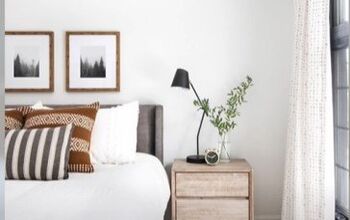7 Common Window Treatment Mistakes & How to Easily Fix Them

Window treatments are such a sticking point when it comes to designing your home. I don't know about you, but I find it so difficult to get drapes or blinds that are the right size, shape, fabric, and sheerness for the room, not to mention that they should also complement the decor style and serve a function.
So, I just found this video on Tips and Ideas for Window Treatments by interior designer Rebecca Robeson and it covers everything you need to know, with a lot of real-life examples from her clients showing what not to do and what to do instead.
Here's her video in full (it's about 25 minutes long) and a summary of the main points below:
Table of contents
Disclaimer: Redesign may receive a small affiliate commission from purchases made via links in this article but at no cost to you.
1. Window treatments should go to the ceiling, not just above the window
Something that Rebecca repeats in this video is that window treatments are actually for the wall, not the window! I know, mind blown!
A key mistake is placing the curtain rod just above the window. Instead, the rod should be installed closer to the ceiling to create a more elongated and elegant look.
2. The fabric should be long enough to reach the floor
Additionally, the fabric itself should be long enough to graze the floor. This prevents the window from appearing visually chopped up and adds a more luxurious feel.
Where to find longer drapes
However, it can be really difficult to find curtains that are the right length, as many stores offer the standard window size (84 inches), rather than accounting for the extra space between the ceiling and the window.
Amazon has lots of options for longer drapes or you can search by the size you need, IKEA has drapes in longer sizes, or as Rebecca suggests, you can buy an extra panel and sew it onto the bottom of your drapes to get the exact length you want.
3. The rod should be wider than the window itself
Another important point is the width of the curtain rod. It should extend well beyond the window on either side. This creates the illusion of a larger window and allows for the curtains to stack back nicely when open.
Spring Tension Rods
If your window treatments are covering the walls, you can use a tension rod between the walls, rather than a rod over the window.
4. Avoid sheer fabrics unless you layer them with something more substantial
Rebecca also advises against using sheer fabrics on their own, especially if privacy is a concern. Sheers can be a nice layering option, but they should be paired with a more substantial fabric for a polished look.
5. Match the style of the window treatments to the style of the room
Choosing the right fabric and style for your window treatments is crucial for creating a cohesive look in your space.
For instance, traditional curtains with elaborate patterns might overwhelm a minimalist room, while simple blinds might look out of place in a more formal setting.
Rebecca encourages us to consider the overall aesthetic of the room and select window treatments that complement it.
6. Consider if you really need window treatments in a particular space
Interestingly, Rebecca also challenges the assumption that every window needs a treatment. In some cases, leaving windows bare can be the most effective design choice.
This is particularly true for spaces with stunning views or unique architectural details that window treatments would only obscure. The key is to evaluate the purpose of the room and make a decision that enhances its overall feel.
7. Use screens and blinds for functionality, not drapes
In Rebecca's own home, she uses drapes as window treatments on the wall; but for privacy and function, she has blinds that come down the windows. That way, the drapes never look messy and don't need to be pulled open or closed.
More window treatment tips
Did you learn anything new from these tips? Let me know in the comments below.






























Comments
Join the conversation